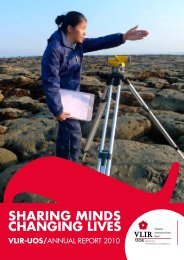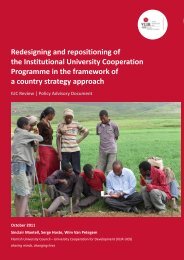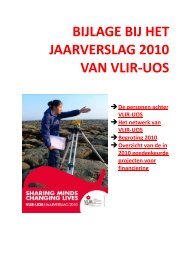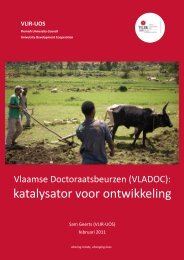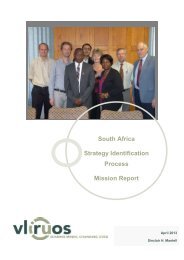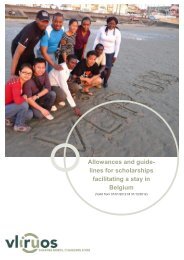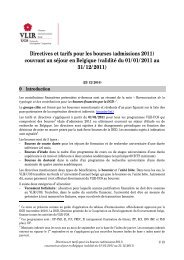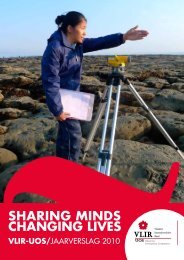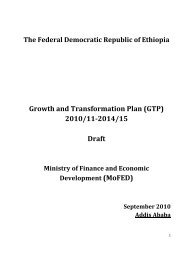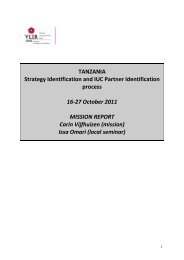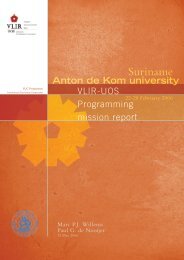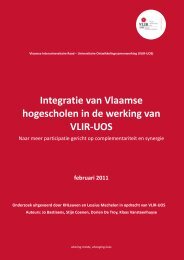Education Sector Development Program - VLIR-UOS
Education Sector Development Program - VLIR-UOS
Education Sector Development Program - VLIR-UOS
Create successful ePaper yourself
Turn your PDF publications into a flip-book with our unique Google optimized e-Paper software.
<strong>Education</strong> <strong>Sector</strong> <strong>Development</strong> <strong>Program</strong> IV<br />
and within the country. Due to the expansion of<br />
postgraduate programs the academic staff has<br />
more than doubled under ESDP III. Thus the<br />
number of academic staff moved from 4,847<br />
in 2004/05 to 11,238 in 2009/10. The share of<br />
females has remained at 10%.<br />
Currently about 1,145 academic staff are attending<br />
PhD programs abroad and within the country.<br />
The performance development process for<br />
academic staff supports a culture of continuous<br />
learning and performance improvement, thus<br />
demonstrating the government’s commitment to<br />
developing and retaining academic talent.<br />
With a view to putting in place a structure<br />
for external quality assurance, HERQA was<br />
established. It developed during the planning<br />
period a mechanism for the accreditation of<br />
private higher education institutions / HEIs and<br />
it initiated a process of auditing both public and<br />
private HEIs.<br />
As part of the national governance reform, the<br />
Higher <strong>Education</strong> Strategy Centre (HESC) was<br />
also created and able to provide support for<br />
policy development and decision-making in<br />
higher education.<br />
Under ESDP III, a renewed emphasis was put<br />
on the relevance of academic programs. The<br />
Convergence Plan adopted in 2008/2009 provided<br />
further guidance when establishing the 70%<br />
and 30% placement objective for sciences &<br />
technology (S&T) and social/human sciences<br />
(SHS). Currently annual intake in the science<br />
and technology to social/human sciences has<br />
reached 58% and 42% respectively.<br />
A major effort was made to equip universities<br />
with state of the art ICT to support both teaching<br />
and administrative processes. A Tele-Conference<br />
Center has been established at the school of<br />
pharmacy by MOE and has begun to provide<br />
service. It provides live transmission and two<br />
way communications and educates around 200<br />
students at the post-graduate level in technology<br />
subject areas.<br />
The old universities have developed and<br />
harmonized their capacity to procure the needed<br />
materials and equipment. Endowments have<br />
been made to equip all 13 new Universities with<br />
laboratory facilities, apparatus, chemicals and<br />
reference books for different subject areas with<br />
special consideration for science and technology<br />
fields.<br />
Universities have developed new curriculum<br />
guidelines in practically all disciplines and are<br />
now implementing them. They are also working<br />
on establishing quality systems.<br />
As a tool for institutional reform, BPR has been<br />
used to achieve institutional transformation in all<br />
universities while the transformation process is<br />
ongoing.<br />
Main challenges<br />
• Despite major expansion, access<br />
to higher education remains<br />
relatively limited (GER of 5,3%<br />
in 2008/2009), and admission<br />
targets have not been met.<br />
• Post-graduate admissions remain<br />
far below the target figures. This<br />
puts serious constraints on the<br />
system in terms of local staff<br />
availability because of the rapid<br />
system expansion.<br />
• The share of female academics<br />
remains far below the target, and<br />
would require serious efforts to<br />
encourage female participation<br />
both at the under-graduate postgraduate<br />
level.<br />
• Open and distance education<br />
remain hardly developed,<br />
Ethiopian Open University has not<br />
been created.<br />
• Undergraduate enrolments<br />
evolve more rapidly than qualified<br />
teachers putting serious<br />
constraints on working conditions<br />
and the quality of education.<br />
• Shortages of qualified Staff both<br />
in public and private sectors<br />
particularly pronounced in<br />
science and technology areas<br />
where enrolments are expected<br />
to increase rapidly.<br />
• Academic staff is very young, and<br />
only a small number has a PhD.<br />
• There are constraints to tap<br />
resources through the internet<br />
and sharing of experiences.<br />
• The private institutions relevance<br />
and quality is not in line with the<br />
expectancy of the government<br />
• There is no strong Technology<br />
Transfer system which is based<br />
on the need of the industry.<br />
• Higher <strong>Education</strong> Management<br />
and Leadership system is not at<br />
the required level.<br />
• The number of female teachers is<br />
limited<br />
63



